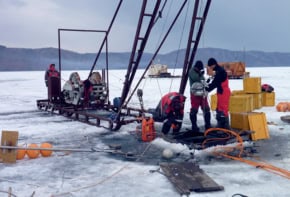How long does it take an electron to jump from one atom to another? According to a team of physicists in Germany and Spain, the answer is just 320 attoseconds. They came to this conclusion using X-ray pulses to watch an electron as it travelled from a sulphur atom to the surface of ruthenium metal. The process was one of the fastest ever studied (Nature 436 373).
Dynamical processes are usually studied by exciting a system with a pulsed pump laser operating at visible wavelengths and tracking how the system evolves using a second, probe pulse. However, these pulses usually last several femotseconds long and so cannot be used to study processes that occur any faster. Ultrafast electron transfer on attosecond scales is, for example, important in photo- and electrochemistry and is exploited in solid-state solar cells, molecular electronics and single-electron devices. It also plays a key role in many biological processes such as photosynthesis.
Wilfried Wurth and colleagues at Hamburg University, Munich University of Technology, Donostia International Physics Center and the University of País Vasco in Donostia-San Sebastián have now found a way of following attosecond processes. They began by firing X-rays at the sulphur, which excites an electron, leaving behind a positive core-hole. The electron then quickly moves onto the ruthenium metal — in less time than it takes for the hole to be filled by another electron. This process is called hole decay, or the “natural lifetime” of the hole, and is known to take 500 attoseconds.
By measuring the spectroscopic signal coming from their sample, the physicists were able to time the electron transfer as taking place in less than 320 attoseconds (320 x 10-18 seconds). Their technique therefore involves using the lifetime of the hole as an internal “stopwatch”.
“Nature provides us with a built in clock for even the fastest processes in atoms and molecules,” lead author Alexander Föhlisch told PhysicsWeb. “Our approach with the core-hole clock method is to use this to follow ultrafast dynamic processes down to the attosecond regime.”
The Germany-Spain team says its method could be extended to study how electrons in different spin states of “up” and “down” travel through materials by using polarized X-rays. This will be important when developing quantum computers and “spintronic” devices that exploit the spin of electrons as well as their charge.



